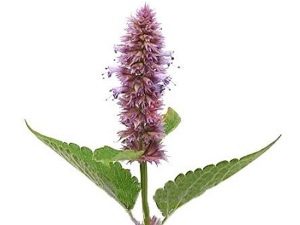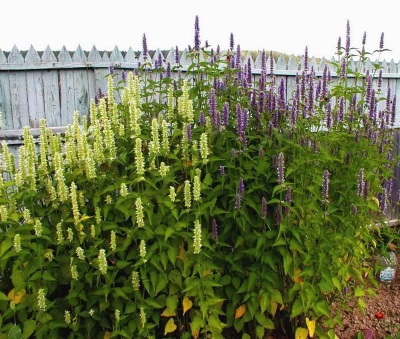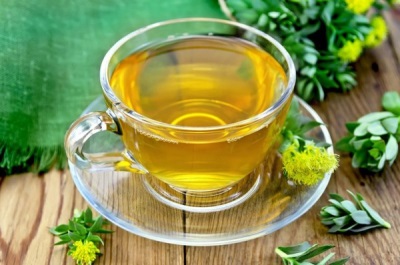Lofant anise

Lofant (Lophanthus anisatus) – This herb is very popular in oriental medicine.
She is credited with various magical properties and is considered by many to be a panacea for almost all diseases.
Depending on the area of growth, it has different names: anise hyssop, licorice mint, and this is not a complete list. These names are based on the characteristics of this plant. The leaves and flowers of the lofant have a mint-anise aroma.

Appearance
This is a perennial herbaceous plant that grows to a height of more than a meter. It is a representative of the Lamiaceae family (Lamiaceae), because its inflorescences are presented in the form of spikelets.
Peculiarities:
- The anise lofant has tetrahedral shoots and oval leaves, the length of the sheet is up to 10 cm, and the width is up to 4 cm, they are serrated at the edges.
- The plant has blue, orange or white flowers depending on the species.
- Its fruit is an oblong dark brown nut.

Kinds
Lofant has more than 25 varieties, but the most popular and in demand for medical purposes and in everyday life are:
- anise lofant with bluish or lilac inflorescences;
- Tibetan lofant with white inflorescences;
- barbera lofant has bright orange inflorescences.



Where does it grow?
The Tibetan lofant grows in some areas of India, China, the Himalayas, Tibet, as well as in Siberia and eastern Russia. The homeland of this plant is Asia Minor, namely savannas and semi-deserts. Also in the wild, this plant can be found in the United States and Canada. There are small plantations in the Crimea and Moldova.

spice making method
- Cut fresh herbs during the growing season;
- Plants are tied in bunches and dried under a canopy;
- Store the lofant in jars, paper bags or linen bags.
Anise lofant spice is very popular, because it gives dishes a special piquancy and opens up new taste sensations. It can be used for fish, meat or vegetable snacks, and it is also added to sweet pastries.
And lofant jam has a simply amazing taste.

Characteristics
- the plant has a very strong aroma that resembles the smell of mint;
- photophilous and drought-resistant;
- grows on light soils;
- can grow in the same place up to 5 years;
- young shoots of the plant appear in March;
- buds begin to appear at the end of May;
- begins to bloom in early July.

Chemical composition
The table shows the main minerals of dry herb anise lofant:
| B (boron) | 20.36 µg/g |
| Ca (calcium) | 10986 mcg/g |
| Fe (iron) | 751 mcg/g |
| I (iodine) | 0.33 µg/g |
| K (potassium) | 11625 mcg/g |
| Mg (magnesium) | 2497 mcg/g |
| Na (sodium) | 2065 mcg/g |
Beneficial features
- protection and strengthening of the body's immunobiological system;
- improves metabolism;
- lowers and normalizes blood pressure.
Anise lofant is rich in vitamins P and C, tannins, essential oils, alkaloids and antibiotics.
Lofant is used for quick recovery after surgery, childbirth, to enhance immunity and to relieve chronic fatigue syndrome.
For residents of large cities with poor ecology, a lofant can be an excellent tool to protect the body from the harmful effects of the environment, and will also help to remove toxic substances and heavy metals from the body.

Harm
- allergic reactions;
- individual intolerance to the plant.
Contraindications
Although anise lofant has medicinal properties, not everyone can use it. Official medicine believes that it causes accelerated growth of cancer cells, therefore, in case of malignant diseases, it is prohibited in any form. But traditional healers have an opposite point of view on this matter and just consider it useful in certain types of cancer. However, it is best to consult your doctor before use.
It is strongly recommended not to use this plant:
- patients with oncological diseases;
- people who are prone to hypotension or thrombophlebitis;
- during pregnancy;
- people suffering from epilepsy;
- with frequent muscle cramps.
Oil
The plant consists of 15% essential oil, which helps to remove toxic substances from the body, because it has 80% methylchavicol. Also, this oil is characterized by bactericidal properties.

Application
In cooking
- fragrant jam is obtained from the plant;
- for sweet confectionery;
- cook compotes;
- for preservation and pickling of vegetables;
- used for liquors and home-made wines;
- in the form of seasoning;
- as side dishes for vegetable, meat or fish dishes.
Lofant is used as a seasoning for vegetable or fruit salads, as well as for a variety of meat dishes, because it has a universal character.
When cooking compotes, fruit drinks or jams, lofant is often added to reveal the taste of berries.

In medicine
- produces a sedative effect;
- has a calming effect;
- relieves severe headaches;
- with atherosclerosis and hypertension;
- normalizes pressure;
- lowers the level of cholesterol in the blood;
- with vegetovascular dystonia;
- helps fight gastritis;
- with problems with the liver;
- with colds;
- slows down the aging of the body;
- when used externally, it has a beneficial effect on the skin, and also helps to speed up the healing of burns or wounds;
- enhances lactation in nursing mothers.

infusions
Lofant herb infusions are widely used:
- with diseases of the pancreas;
- with problems with the gastrointestinal tract;
- with diseases of the kidneys and urinary tract;
- after a stroke or heart attack;
- with bronchial asthma and bronchitis.
The stem, inflorescences and foliage of the plant are used in the manufacture of medicines. To increase male potency, the leaves must be consumed fresh.

Tincture recipe:
- dry lofant color (50 grams) or fresh (200 grams);
- half a liter of forty-degree vodka.
It is necessary to fill the grass with vodka and let it brew in a dark place for about three weeks, shaking every day.
When the tincture is ready, you need to strain through a strainer and take orally twice a day, one teaspoon half an hour before meals. The course of treatment is one month, then you should wait a week and start the course of treatment again.
This tincture has a beneficial effect on the body:
- lowers blood pressure;
- strengthens the immune system;
- has a beneficial effect on the work of the heart;
- eliminates trembling of the limbs.
You can use lofant tea to strengthen the body, this drink will be especially useful for people after a heart attack. You should take one tablespoon of herbs in a cup of boiling water, let it brew for half an hour and you can drink it with honey. This tea should be consumed three times a day to get the desired result.

At home
- used for decorative purposes, because the plant has a beautiful appearance;
- the plant is an excellent honey plant, because it is very popular among bees;
- is indispensable in cosmetology, it is added to creams, face and hair masks.

Varieties
- Astrakhan 100;
- Summer resident;
- Premier;
- Snowball;
- Dandy.
Premier and Frant have lilac flowers, and the rest of the varieties have white inflorescences.

cultivation
The growth of the anise lofant begins in early March, the buds ripen in May, and flowering usually occurs in early July. Growing a plant is not difficult at all, you can even plant it on a balcony or in a room.

Lofant can be grown from seeds or seedlings. In the spring, you need to plant in the ground to a depth of 3 mm. Between crops in a row should be left 10 cm, and between rows - up to 45 cm. When seedlings appear, only strong shoots should be left.
The plant grows well and does not need special care, because it is drought-resistant. Weed the lofant several times and water occasionally. You don't have to deal with insects.


















Wow! There are contraindications even with oncology, but I didn’t know.
Planted in a cucumber bed from one side - they are very good friends.
Interesting!
I read a lot about lofant, but I see for the first time that it cannot be used in oncology. I have a lot of it growing in the country, I supplied everyone with this plant.
The anise lofant grows freely on our site: where there is a free place, it settles there. He himself "went" into the greenhouse, and stayed there around the entire perimeter. He is friends with cucumbers, and with peppers, and with eggplants, collects bees and wasps. Thanks to the lofant, there are almost no pests, diseases are also bypassed. Periodically overgrown bushes are cut, chopped and mulched plantings. My husband and I are both hypertensive and drink lofant tea with pleasure. In addition, the plant is very beautiful, a real decoration of the site. All in all, a wonderful plant!